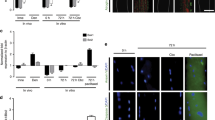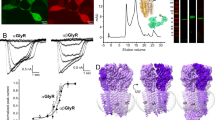Abstract
As Kravitz et al.1 have pointed out, glutamic acid is at present the only candidate for the excitatory transmitter at crustacean neuromuscular junctions. The evidence is that1,2 glutamic acid is the most potent excitatory substance present in the crustacean central nervous system (CNS), whole peripheral nerves and isolated excitatory axons1,3–5; that the glutamic acid content in nerve extracts accounts for the whole of their excitatory activity on crustacean muscles1, and that the receptors to glutamate are localised at the same junctional spots as the receptors to the natural excitatory transmitter6. Also, both glutamic acid and the natural transmitter produce similar changes in the permeability of the postjunctional muscle membrane7–9 and in spite of a large background leakage, a significant release of glutamic acid can be evoked by stimulation of excitatory nerves1. There is also a selective uptake of glutamic acid at the neuromuscular junction which could provide an inactivation mechanism10. There is, however, no information on whether glutamate receptors have the same pharmacological properties as the receptors of the natural excitatory transmitter.
This is a preview of subscription content, access via your institution
Access options
Subscribe to this journal
Receive 51 print issues and online access
$199.00 per year
only $3.90 per issue
Buy this article
- Purchase on Springer Link
- Instant access to full article PDF
Prices may be subject to local taxes which are calculated during checkout
Similar content being viewed by others
References
Kravitz, E. A., Slater, C. R., Takahashi, K., Bownds, M. D., and Grossfeld, R. M., in Excitatory Synaptic Mechanisms (edit. by Andersen, P., and Jansen, J. K. S.), 84 (Universitet Forlaget, Oslo, 1970).
Gerschenfeld, H. M., Physiol. Rev., 53, 1 (1973).
Dudel, J., Gryder, R., Kaji, A., Kuffler, S. W., and Potter, D. D., J. Neurophysiol., 26, 721 (1963).
Kravitz, E. A., Kuffler, S. W., Potter, D. D., and van Gelder, N. M., J. Neurophysiol., 26, 729 (1953).
Kravitz, E. A., Kuffler, S. W., and Potter, D. D., J. Neurophysiol., 26, 739 (1963).
Takeuchi, A., and Takeuchi, N., J. Physiol., Lond., 170, 296 (1964).
Ozeki, M., and Grundfest, H., Science, 155, 478 (1967).
Tarashkevitch, P. S., Biochim. biophys. Acta, 241, 700 (1971).
Takeuchi, A., and Onodera, K., Nature new Biol., 242, 124 (1973).
Iversen, L. L., and Kravitz, E. A., J. Neurochem., 15, 609 (1968).
Kennedy, D., and Evoy, W. H., J. gen. Physiol., 49, 467 (1966).
Kennedy, D., and Takeda, K., J. exp. Biol., 43, 229 (1965).
Curtis, D. R., Hosli, L., Johnston, G. A. R., and Johnston, I. H., Expl Brain Res., 5, 235 (1966).
Kehoe, J. S., J. Physiol., Lond., 225, 115 (1972).
Diamond, J., Roper, S., and Yasargil, G. M., J. Physiol., Lond., 232, 87 (1973).
Parnas, I., and Atwood, H. L., J. cell Physiol., 68, 1 (1966).
Haldeman, S., and McLennan, H., Brain Res., 45, 393 (1972).
Author information
Authors and Affiliations
Rights and permissions
About this article
Cite this article
LOWAGIE, C., GERSCHENFELD, H. Glutamate antagonists at a crayfish neuromuscular junction. Nature 248, 533–535 (1974). https://doi.org/10.1038/248533a0
Received:
Issue Date:
DOI: https://doi.org/10.1038/248533a0
This article is cited by
-
Effects of DL-?-aminoadipate on synaptic transmission in spinal interneurons of the lamprey
Journal of Comparative Physiology ? A (1981)
-
Methyltetrahydrofolate is a potent and selective agonist for kainic acid receptors
Nature (1980)
-
Long-lasting depression and the depletion hypothesis at crayfish neuromuscular junctions
Journal of Comparative Physiology ? A (1977)
-
Aspartate and other inhibitors of excitatory synaptic transmission in crayfish muscle
Pfl�gers Archiv European Journal of Physiology (1977)
-
Neurohumoral and reflex control of scaphognathite beating in the crabCarcinus maenas
Journal of Comparative Physiology ? A (1977)
Comments
By submitting a comment you agree to abide by our Terms and Community Guidelines. If you find something abusive or that does not comply with our terms or guidelines please flag it as inappropriate.



